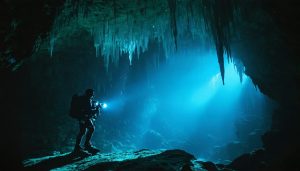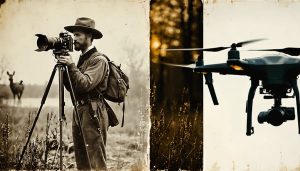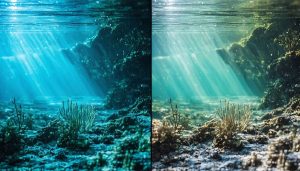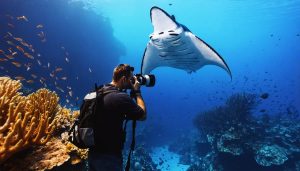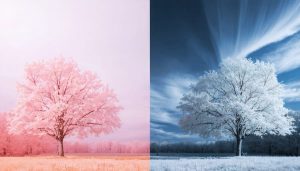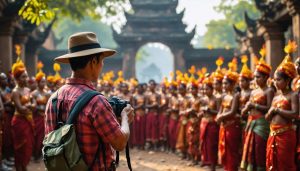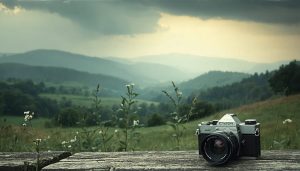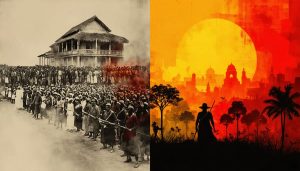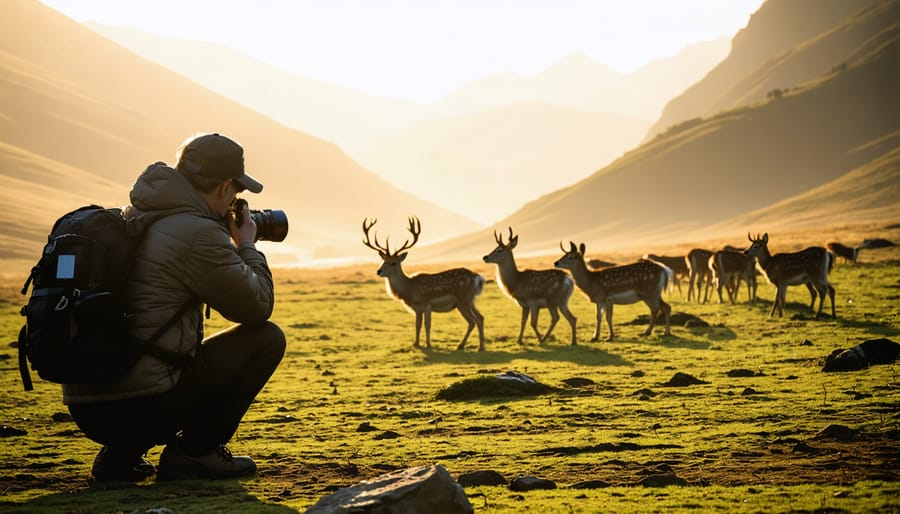
Crouch low in dawn’s golden light, where wildlife and landscapes merge to create breathtaking compositions that tell powerful conservation stories. Master the delicate balance between capturing intimate animal behavior and showcasing the grandeur of their natural habitats through precise camera positioning and thoughtful framing. Combine the technical precision of wildlife photography with the patient observation required for conservation through photography, transforming fleeting moments into compelling visual narratives that advocate for environmental preservation.
Pack ultra-telephoto lenses (400mm-600mm) alongside wide-angle options (16-35mm) to seamlessly transition between intimate wildlife portraits and sweeping environmental contexts. Position yourself where animal paths intersect with dramatic landscape features—ridgelines, water sources, or natural frames—during golden and blue hours when light paints the scene in rich, emotionally resonant colors.
Study animal behavior patterns, seasonal migrations, and habitat preferences before arriving on location. This preparation, combined with weather forecasting and topographical research, maximizes opportunities to capture those rare moments when wildlife, landscape, and light align perfectly. Remember: exceptional landscape wildlife photography demands equal measures of technical expertise, field craft, and unwavering respect for the natural world.
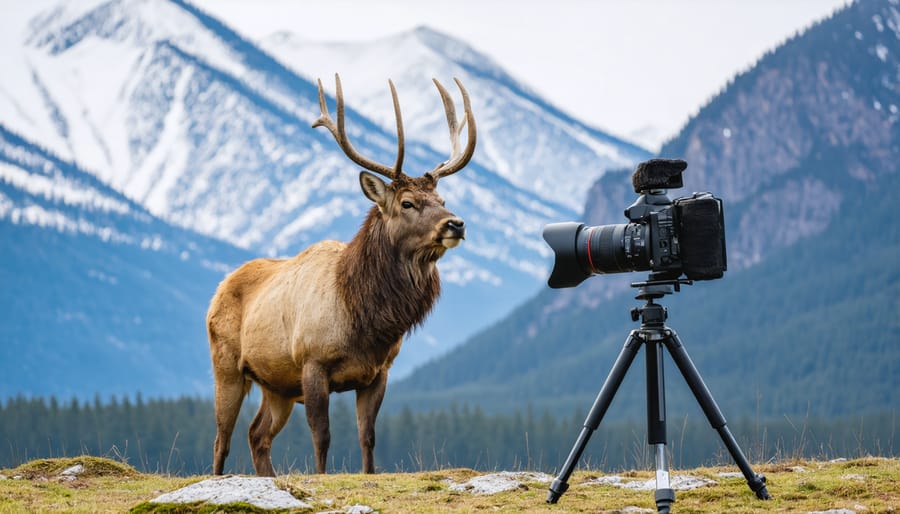
Essential Gear for Landscape Wildlife Photography
Choosing the Right Lens
Selecting the right lens is crucial for capturing compelling wildlife landscapes, and the telephoto lens is your most valuable tool in this genre. While wide-angle lenses excel at traditional landscapes, wildlife often requires you to maintain a safe distance both for your safety and the animals’ well-being.
For most wildlife landscape scenarios, a focal length between 200mm and 600mm provides the versatility you need. A 70-200mm lens serves as an excellent starting point, offering enough reach for larger animals while maintaining the ability to capture environmental context. For smaller creatures or more distant subjects, consider a 100-400mm or 150-600mm lens, which allows you to frame intimate portraits while including habitat elements.
The choice between prime and zoom lenses depends on your shooting style. Prime telephotos, like a 400mm f/2.8, deliver exceptional image quality and perform well in low light but limit compositional flexibility. Zoom lenses offer more versatility in the field, letting you quickly adapt to changing scenes and animal movements.
Remember that longer focal lengths compress perspective, making distant elements appear closer together. This compression can create dramatic effects, particularly when photographing animals against mountain backdrops or during golden hour. However, longer lenses also amplify camera shake, so consider image stabilization features and potentially invest in a sturdy tripod for sharper images.
Support Systems and Stability
When photographing wildlife in natural landscapes, a reliable support system isn’t just helpful – it’s essential. A sturdy tripod is your best friend, especially during those dawn and dusk hours when light is limited and longer exposure times are necessary. Look for a tripod that balances weight and stability; carbon fiber models offer excellent rigidity while remaining lightweight enough for extended treks through the wilderness.
For situations where setting up a tripod isn’t practical, a monopod can be a game-changer. It’s particularly useful when tracking moving subjects like birds in flight or animals on the move, providing that crucial extra stability while maintaining mobility. Consider models with feet that fold out at the base for additional support.
Bean bags are often overlooked but incredibly versatile support systems. They’re perfect for shooting from vehicle windows during safari-style photography and can be easily positioned on rocks or fallen logs in the field. Some photographers even fill their bags with rice or beans at their destination to avoid extra weight during travel.
Image stabilization technology, whether in-lens or in-camera, complements these physical supports beautifully. However, don’t rely on it exclusively – combining it with proper physical support will consistently deliver sharper images, especially when using longer focal lengths common in wildlife photography.
Remember to always secure your equipment properly, using a quick-release system that allows for swift but secure attachment and detachment. This can be crucial when that perfect moment presents itself unexpectedly.
Composition Techniques for Wildlife Landscapes
Environmental Context
The environment surrounding wildlife is just as crucial as the subject itself in creating compelling photographs. Understanding and effectively incorporating habitat elements can transform a simple wildlife portrait into a story-rich image that showcases the animal in its natural context. When approaching composition fundamentals, consider how environmental elements like vegetation, rock formations, or water bodies can frame your subject and add depth to your images.
Look for opportunities to capture animals interacting with their surroundings – whether it’s a deer emerging from morning mist, a bird perched against a dramatic sunset, or a bear fishing in a mountain stream. These environmental elements not only provide context but also help convey the animal’s behavior and lifestyle in its natural habitat.
Weather conditions and seasonal changes can dramatically impact your environmental shots. Fog, rain, snow, or golden hour lighting can create atmospheric conditions that enhance the mood of your images. When capturing remote landscapes with wildlife, try to position yourself where the background complements rather than competes with your subject.
Pay attention to the scale relationship between the animal and its environment. Sometimes showing a small subject within a vast landscape can create a powerful image that speaks to the animal’s place in the ecosystem. Alternatively, filling the frame with both subject and immediate habitat can reveal intimate details about the species’ living conditions and behavioral patterns.
Remember to maintain a clean composition by avoiding distracting elements while still including enough environmental context to tell the complete story of your wildlife subject.
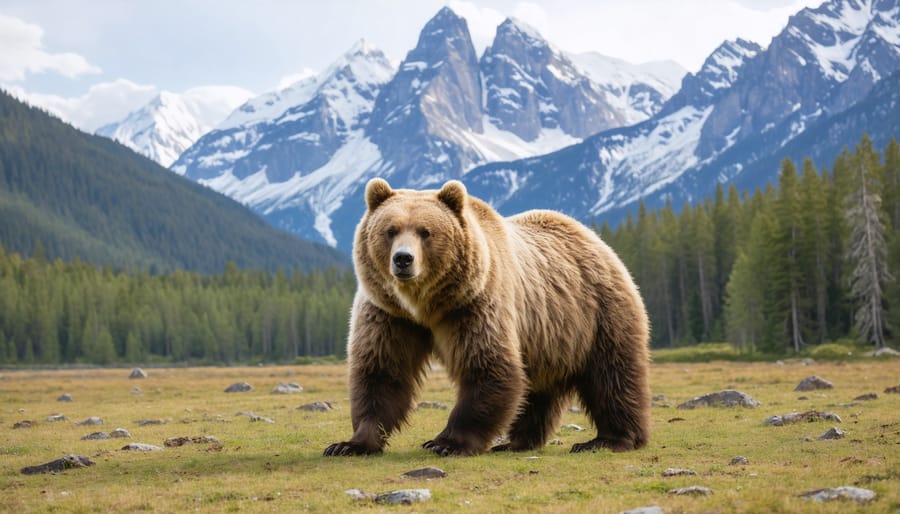
Animal Positioning and Behavior
Understanding and anticipating animal behavior is crucial for capturing compelling wildlife images within landscapes. The key is to observe your subjects from a safe distance while remaining patient and vigilant. Animals tend to be most active during golden hours – early morning and late afternoon – which conveniently coincides with the best lighting conditions for landscape photography.
When composing your shot, look for natural patterns in animal behavior. Many species follow regular routines, visiting the same watering holes or feeding grounds at specific times. Research your subject species beforehand to understand their habits and preferred habitats. This knowledge will help you position yourself strategically without disturbing their natural behavior.
Consider the animal’s eye level and perspective within the landscape. While a wide vista can be breathtaking, dropping to ground level can create more intimate and engaging wildlife portraits that still incorporate the surrounding environment. Pay attention to the animal’s line of sight and movement direction, leaving space in the frame for them to “move into.”
Weather conditions can significantly impact animal behavior. On windy days, many animals become more cautious and alert, while overcast conditions might encourage more active feeding behavior. Learning to read these environmental cues will improve your success rate dramatically.
Remember that certain behaviors, like feeding, mating, or caring for young, often provide the most compelling photographic opportunities. However, always prioritize the animal’s welfare over getting the shot. If you notice signs of stress or changed behavior due to your presence, slowly back away and reassess your position.
Light and Timing
Golden Hour Photography
The golden hour – that magical time just after sunrise and before sunset – offers wildlife photographers an unparalleled opportunity to capture stunning images. During these precious moments, the sun’s low position creates warm, directional light that bathes landscapes and wildlife in a soft, golden glow, adding depth and dimension to your photographs.
In the early morning, animals are typically more active as they begin their daily routines. This increased activity, combined with the beautiful morning light, presents perfect conditions for capturing authentic wildlife behavior. The low-angle sunlight creates long shadows and rim lighting that can highlight an animal’s form and texture, while the warm color temperature adds a captivating atmosphere to your shots.
Late afternoon golden hour offers similar lighting conditions but with a different energy. As animals prepare for evening activities or settle down for the night, you can capture intimate moments in beautiful, warm light. The lower contrast during these hours also means you won’t struggle with harsh shadows that often plague midday wildlife photography.
To make the most of golden hour photography:
– Arrive at least 30 minutes before sunrise or sunset to prepare your equipment
– Use spot metering to handle the directional light effectively
– Position yourself with the sun at your back when possible
– Look for opportunities to capture backlit subjects for dramatic silhouettes
– Consider using a graduated neutral density filter to balance bright skies with darker foregrounds
Remember that timing is crucial – these golden moments are fleeting, so careful planning and quick adaptation are essential for success.
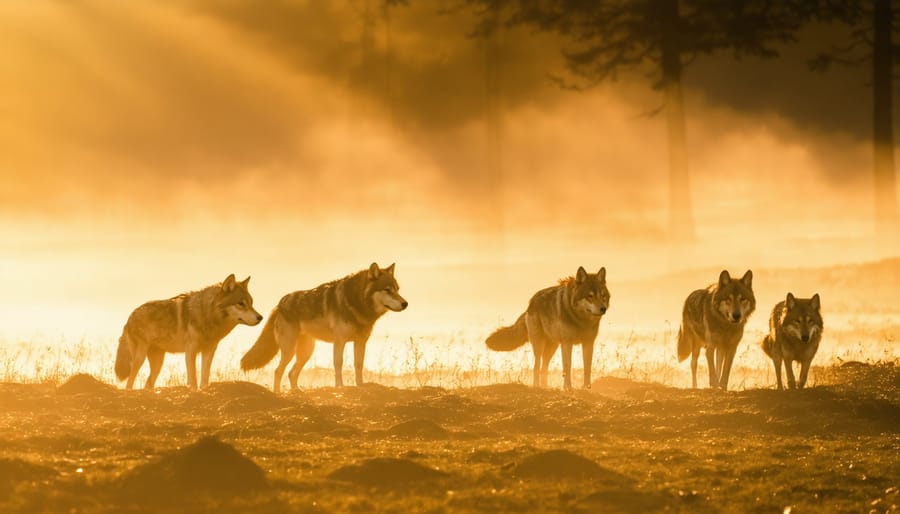
Weather Conditions
Weather conditions play a crucial role in wildlife landscape photography, often making the difference between a good shot and an extraordinary one. Golden hour during sunrise and sunset provides warm, directional light that can transform ordinary scenes into magical moments, while also coinciding with peak animal activity periods.
Overcast days, while sometimes overlooked, offer perfect conditions for capturing subtle details and colors without harsh shadows. The soft, diffused light acts like a giant softbox, making it ideal for photographing animals in forest environments or capturing intricate textures in fur and feathers.
Fog and mist create atmospheric conditions that add depth and mystery to your wildlife landscapes. These conditions work particularly well for creating silhouettes of larger animals or capturing the early morning activities of creatures emerging from their nocturnal routines.
Rain shouldn’t deter you from shooting – some of the most compelling wildlife images happen during or just after precipitation. Animals often display interesting behaviors in wet conditions, and water droplets can add dramatic elements to your compositions. Just ensure your gear is properly weather-sealed.
Snow presents unique opportunities for minimalist compositions and tracking wildlife, though it requires careful exposure compensation to maintain detail in white areas. Winter conditions also showcase animals’ survival adaptations, creating compelling documentary opportunities.
Remember that changing weather can trigger specific animal behaviors, so understanding these patterns helps you anticipate and prepare for memorable shooting opportunities.
Conservation Photography Ethics
Minimizing Impact
As wildlife photographers, our primary responsibility is to protect the very subjects we seek to capture. Always maintain a safe distance using telephoto lenses rather than approaching animals directly. A good rule of thumb is if the animal changes its behavior because of your presence, you’re too close.
Research your subjects before heading out. Understanding their habits and behaviors helps you predict movement patterns and set up shots without causing disturbance. Dawn and dusk are typically the best times for wildlife activity, and staying in one location quietly is often more productive than actively pursuing animals.
Never bait or lure wildlife for a photo opportunity. This can alter natural behaviors and create dangerous dependencies. Similarly, avoid using flash photography with nocturnal animals, as it can disorient them and disrupt their hunting patterns.
Be mindful of your surroundings and stick to designated trails. Trampling vegetation or disturbing nesting sites can have lasting impacts on ecosystems. During breeding seasons, exercise extra caution and consider whether getting the shot is worth potentially disturbing crucial wildlife activities.
Pack out what you pack in, and leave no trace of your presence. Consider joining local wildlife photography groups that promote ethical practices and share location-specific guidelines. Remember, a great wildlife photo isn’t just about technical excellence – it’s about capturing authentic moments while preserving the natural world for future generations.
Documentation for Conservation
Wildlife photography can play a crucial role in conservation efforts when approached thoughtfully and systematically. To make your images valuable for conservation, focus on documenting behaviors, habitats, and environmental challenges that tell compelling visual stories about species and their ecosystems.
Keep detailed records of your wildlife encounters, including date, time, location, and any observed behaviors. This metadata can be invaluable for researchers tracking population patterns and habitat use. Consider partnering with local conservation organizations or wildlife biologists who can guide you toward priority species or areas needing documentation.
Focus on capturing images that show both the beauty of wildlife and the challenges they face. Document habitat degradation, human-wildlife conflicts, and conservation success stories. These images can become powerful tools for education and advocacy.
Maintain accurate species identification in your image catalogs and consider submitting your photographs to wildlife databases or citizen science projects. Many organizations use crowd-sourced wildlife photography to monitor population trends and distribution patterns.
Remember to follow ethical photography practices while documenting wildlife. This includes maintaining safe distances, avoiding behavior disruption, and being transparent about any managed shooting situations. Your images should serve as authentic records of wildlife in their natural state, making them valuable resources for conservation efforts worldwide.
Post-Processing for Impact
Post-processing wildlife landscape images requires a delicate balance between enhancement and authenticity. The goal is to bring out the natural beauty of your captures while maintaining the integrity of the scene. Start with basic adjustments like exposure and contrast to ensure your subject stands out naturally against the landscape.
Color temperature adjustments are crucial in wildlife landscapes, as golden hour shots often need fine-tuning to accurately represent the warm light. Use selective brushing to enhance the fur or feathers of your subject without affecting the surrounding environment. This technique helps maintain the natural look while drawing attention to your wildlife subject.
When working with shadows and highlights, avoid pushing them too far. Nature presents its own perfect balance, and excessive HDR can make your images appear artificial. Instead, use graduated filters to balance bright skies with darker foregrounds, maintaining the scene’s natural feel.
For those working with mobile photography techniques, many apps now offer sophisticated editing tools that rival desktop software. However, regardless of your editing platform, remember that less is often more when it comes to wildlife landscapes.
Consider using subtle vignetting to direct attention to your subject without making it obvious. Clarity and texture adjustments can enhance environmental details like rocks, water, or foliage, but use them sparingly to avoid an over-processed look.
Finally, always preserve your original files and work non-destructively. This allows you to revisit your edits as your skills evolve and ensures you maintain an authentic record of your wildlife encounters. Remember, the best post-processing often goes unnoticed, letting the natural beauty of your wildlife subject and its habitat shine through.
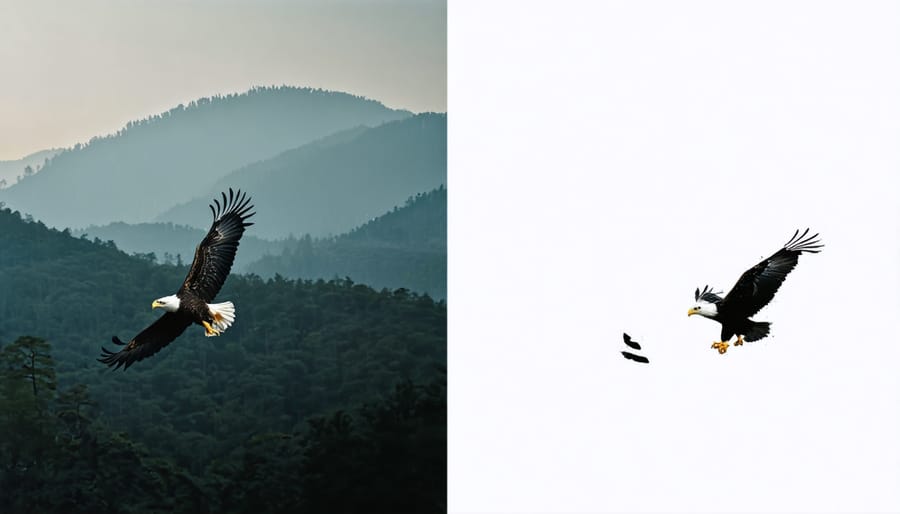
Landscape wildlife photography is more than just capturing stunning images – it’s about being a responsible steward of the natural world while creating meaningful visual stories. Throughout this guide, we’ve explored the essential equipment, techniques, and approaches needed to capture wildlife in their natural habitats successfully.
Remember that patience and preparation are your greatest allies in this field. Taking the time to research your subjects, understand their behaviors, and respect their space will not only result in better photographs but also ensure the wildlife’s wellbeing. Always prioritize the animal’s welfare over getting the perfect shot.
The key to successful landscape wildlife photography lies in finding the balance between technical excellence and ethical practices. Maintain safe distances, avoid baiting or disturbing animals, and never compromise their natural behaviors for the sake of a photograph. Consider joining local wildlife photography groups or conservation organizations to stay informed about best practices and contribute to wildlife protection efforts.
As you develop your skills, focus on creating images that tell compelling stories about the relationship between wildlife and their environments. These photographs can become powerful tools for conservation awareness and environmental education.
Whether you’re photographing birds in flight, mammals in their natural habitat, or capturing intimate moments of animal behavior, always approach your subjects with respect and mindfulness. The future of wildlife photography depends on photographers who not only master their craft but also serve as ambassadors for wildlife conservation.
Take these lessons into the field, continue learning, and remember that every wildlife photograph you take has the potential to inspire others to appreciate and protect our natural world.

